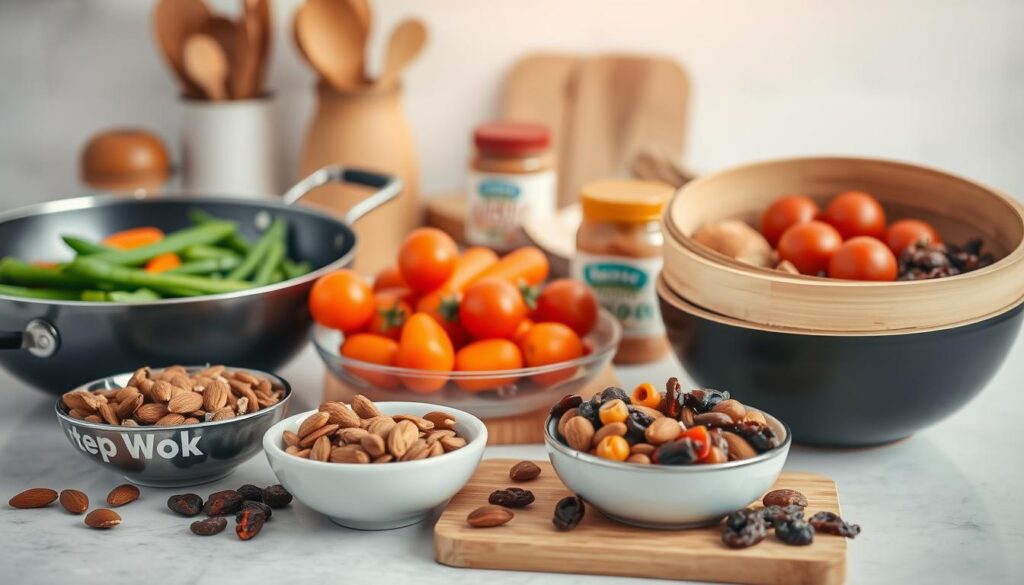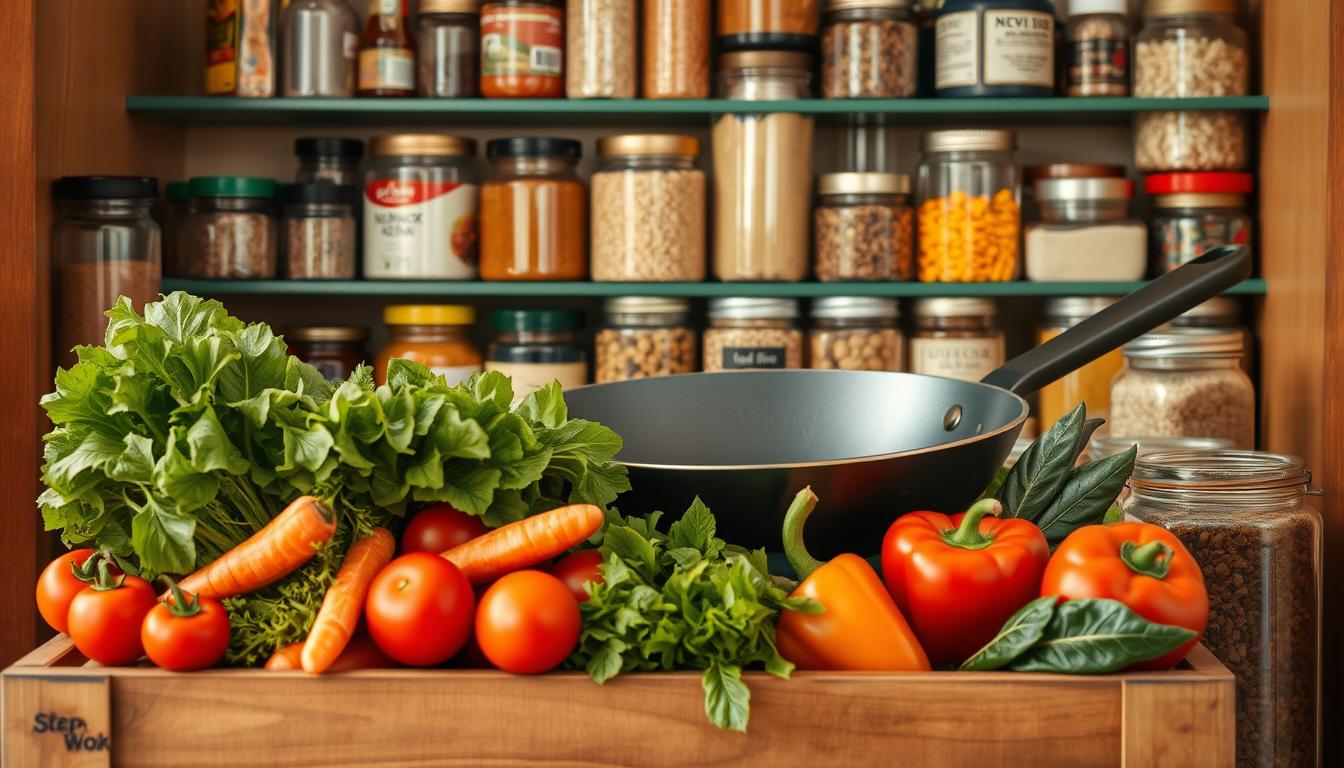A well-stocked pantry is key for everyday cooking. It provides a base for many meals and cuts down on food waste. With the right pantry staples, you can make a variety of dishes quickly and easily.
Having grains, canned goods, spices, and oils ready can save you time and money. It makes it simpler to create tasty and healthy lunches.
Statistics show that 75% of families feel stressed about planning dinner. A well-stocked pantry can help. It can save you about 30% on groceries.
Having the right pantry items can also cut down meal prep time. Instead of 60 minutes, you can prepare meals in just 30 minutes. This makes it easier to cook healthy and delicious meals.
Key Takeaways
- A well-stocked pantry can help reduce food waste and save time
- Essential pantry staples include grains, canned goods, spices, and oils
- Stocking up on pantry essentials can lead to household grocery savings of approximately 30%
- Having key pantry items on hand can reduce meal preparation time by up to 50%
- Pantry staples such as pasta and rice are included in nearly 90% of American households
- A fully stocked pantry can lead to a decrease in food waste by 20%
- Utilizing pantry staples can make it easier to prepare quick and healthy lunch recipes
The Importance of a Well-Stocked Pantry
A well-stocked pantry is key for meal prep and everyday cooking. It gives you the basics for many dishes. This way, you can quickly make meals without relying on takeout or dining out.
Cooking at home is healthier than eating out. A stocked pantry helps reduce food waste and saves time and money. In fact, the average American household throws away 30-40% of food, which can be cut down with a well-stocked pantry.
Why Pantry Staples Matter
Pantry staples like canned goods and dried beans can last up to 2 years. Onions can last 4 to 6 months, and garlic 3 to 5 months. Having these items ready means you won’t have to make impulse buys, which can cost up to 20% more.
How They Save Time and Money
A well-stocked pantry can save you up to 1 hour a week on grocery shopping. Using pantry staples can make dinners quicker, often under 30 minutes. This way, families can save up to 25% on grocery bills, thanks to sales on staple items.
- Reduced food waste
- Saved time and money
- Increased cooking frequency
- Improved meal planning and organization
By using meal prep and pantry staples, cooking becomes easier, faster, and more fun. Home cooks can enjoy these benefits and more.
Basic Grains to Include in Your Pantry
Grains are key when stocking your pantry with essential ingredients. Whole grains like farro, barley, brown rice, and steel-cut oats are great. They offer health benefits. Quick-cooking grains, such as white rice, quinoa, rolled oats, and couscous, are also good choices.
Don’t forget kitchen essentials like pasta. It’s a reliable meal option with many varieties. Stores now offer gluten-free pasta made from rice, quinoa, or beans. This makes it easier to meet dietary needs.
Some important grains to have in your pantry are:
- Brown rice
- Quinoa
- Steel-cut oats
- Pasta (including gluten-free options)
By having these basic grains, you’ll set a strong foundation for cooking. You’ll be ready to try out new recipes.
| Grain | Health Benefits | Cooking Time |
|---|---|---|
| Brown Rice | High in fiber and nutrients | 40-50 minutes |
| Quinoa | Complete protein and high in fiber | 15-20 minutes |
| Steel-cut Oats | High in fiber and nutrients | 20-30 minutes |
Essential Canned Goods for Quick Meals
Canned goods are a must-have in many kitchens. They offer a quick and affordable way to cook meals. For everyday cooking, having the right pantry staples for lunch is key. Canned vegetables, beans, and tomatoes are essential.
Some of the most popular canned goods include:
- Canned tomatoes, available in crushed, diced, and whole forms
- Canned beans, like kidney, black, and chickpeas
- Canned vegetables, such as corn and green beans
These items can be used in many dishes, from soups to salads. They add nutrition to meals, packed with vitamins and minerals. For instance, canned tomatoes are full of lycopene, an antioxidant with health benefits.

Canned goods are also convenient and budget-friendly. They last long, perfect for meal planning. With some creativity, you can make tasty, healthy meals using them.
| Canned Good | Nutritional Value | Uses |
|---|---|---|
| Canned Tomatoes | Rich in lycopene and vitamins | Soups, stews, sauces, salads |
| Canned Beans | High in protein and fiber | Soups, stews, salads, dips |
| Canned Vegetables | Rich in vitamins and minerals | Soups, stews, salads, side dishes |
The Must-Have Spices and Herbs
Spices and herbs are key pantry staples that make any dish better. For great meal prep, a good spice rack is a must. Essential spices include black pepper, cumin, and turmeric.
Black pepper comes from peppercorns and is full of Vitamin K. It’s a staple in Western cooking. Cumin is one of the oldest spices and is in many spice blends. Turmeric is used in about 45% of Indian and Thai dishes.
Basil, parsley, thyme, and rosemary are also must-haves. They’re great in soups, stocks, sauces, and marinades. For instance, bay leaves flavor 50% of soups and stocks. Garlic powder is 25% more flavorful than granulated garlic.
Preselected spice sets like Spicewalla’s Kitchen Essentials or Burlap & Barrel’s Fundamental set are handy. When buying spices, look for fair trade labels and ethically sourced products.
| Spice/Herb | Usage | Flavor Profile |
|---|---|---|
| Black Pepper | Savory dishes | Sharp, pungent |
| Cumin | Curry powder, taco seasoning | Warm, earthy |
| Turmeric | Indian and Thai dishes | Bright, slightly bitter |
Adding these spices and herbs to your pantry staples and kitchen essentials will elevate your meal prep. You’ll make delicious, flavorful dishes easily.
Cooking Oils and Fats: An Overview
Cooking oils and fats are key in every kitchen. They affect the taste and health of our food. Each oil, like olive or coconut, has its own benefits and uses.
Common oils include olive, canola, and avocado. These are great because they’re versatile and good for you. For instance, olive oil is full of antioxidants and tastes great in salads. Canola oil is good for baking because it doesn’t burn easily.
Choosing the right oil is important. Look at their smoke points, which tell you when they start to smoke. High smoke point oils like peanut and avocado are best for hot cooking. Low smoke point oils, like olive, are better for slow cooking. Having many oils means you’re ready for any recipe.
- Olive oil: rich in antioxidants, distinct flavor, low smoke point
- Canola oil: neutral flavor, high smoke point, rich in monounsaturated fats
- Avocado oil: high smoke point, rich in monounsaturated fats, mild flavor
- Peanut oil: high smoke point, rich in monounsaturated fats, nutty flavor
Knowing about different oils helps you pick the best for your dishes. This way, your meals will taste great and be good for you too.
Condiments to Elevate Your Lunch
Having the right condiments can change your everyday cooking game. They are essential ingredients that can turn your lunch from ordinary to amazing. With the right condiments, your pantry staples for lunch can become tasty and fulfilling meals.
Best Sauces for Flavor Boost
- Chile paste: adds a spicy kick to your dishes
- Dijon mustard: provides a tangy and creamy flavor
- Olive tapenade: enhances the flavor of your salads and sandwiches
Must-Have Dressings for Quick Salads
Right dressings can also make a big difference in your salads. Key ingredients for salad dressings include olive oil, red wine vinegar, and Dijon mustard. Adding chile crisp or red curry paste can also bring some heat.
| Condiment | Usage |
|---|---|
| Chile crisp | Adding flavor to pantry staples for lunch |
| Olive tapenade | Enhancing salad dressings |
| Red curry paste | Adding heat to salad dressings |
The Power of Frozen Foods
Frozen foods are a great addition to meal prep and can be valuable pantry staples for lunch. They offer a convenient way to store food for everyday cooking. Many frozen options retain essential vitamins and minerals. In fact, frozen fruits and vegetables are often more nutritious than fresh produce that has been stored for some time.
Some benefits of frozen foods include their long shelf life and reduced food waste. According to the USDA, food stored consistently at 0°F remains safe to eat, regardless of storage duration. This makes frozen foods a great option for meal prep and everyday cooking. When choosing frozen foods, it’s essential to select options with low or no added sugars and unhealthy fats.
Some popular frozen food options for meal prep and pantry staples for lunch include:
- Frozen vegetables like green beans, peas, and spinach
- Frozen fruits like peaches, berries, and cherries
- Frozen proteins like beef, chicken, and raw shrimp
These options can be easily incorporated intoeveryday cooking. They provide a convenient way to add nutrients and variety to meals.
Dairy and Dairy Alternatives
Stocking your pantry with essential ingredients means having dairy and dairy alternatives. These kitchen essentials can make your cooking better. They are key for many dishes, from cheeses to milk and yogurt.
Many people choose pantry staples like non-dairy milk. Options include almond, soy, or coconut milk. They work well in smoothies and baked goods, making great substitutes for dairy.
Here are some top picks for dairy and dairy alternatives:
- Milk (dairy and non-dairy)
- Yogurt (dairy and non-dairy)
- Cheese (dairy and non-dairy)
- Butter and margarine
Adding these essential ingredients to your pantry is smart. It helps you cook and bake better, no matter your skill level. A well-stocked dairy and dairy alternative section makes cooking easy and fun.
Snack Staples for Midday Boosts
Having the right pantry staples for lunch is key for everyday cooking. A well-stocked pantry with essential ingredients lets you make quick, nutritious meals or snacks.
Whole grain pastas, beans, and nuts are great. Canned goods like veggies and soups heat up fast for a tasty meal. Nut butters, honey, and coconut milk are also great for healthy snacks.
Here are some more snack staples:
- Nut butters, like almond or peanut butter, are good with fruit or crackers.
- Dried fruits and nuts are full of fiber and protein.
- Energy balls made with oats, nuts, and dried fruits are a tasty snack.
Adding these pantry staples for lunch to your daily routine means you’ll always have healthy snacks. They’re perfect for a quick energy boost or a filling meal. These essential ingredients help you stay on track all day.

Conclusion: Building Your Pantry for Success
Having a well-stocked pantry is key for easy meal prep and everyday cooking. It saves time, cuts down on waste, and lets you make tasty, healthy meals quickly.
Maintaining and Updating Your Pantry Essentials
Check your pantry staples often and restock when needed. This way, you’re always ready for quick lunches or dinners. Use a checklist or pantry organizer to keep track of what you have.
Final Tips for Everyday Cooking
Now that your pantry is ready, you can face any cooking task. Try new recipes, explore different flavors, and let your imagination run wild. A well-stocked pantry opens up a world of tasty, easy meals.

